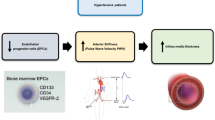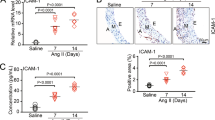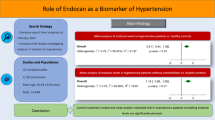Abstract
The aim of the study was to examine whether the circulating cell adhesion molecules, von Willebrand factor (vWf) and endothelin-1, are elevated in patients with essential hypertension with no other risk factors for atherosclerosis and thus may serve as a markers of endothelial dysfunction in uncomplicated hypertension. Furthermore, the effect of treatment with the ACE inhibitor, quinapril, on levels of endothelial dysfunction markers were studied. The levels of adhesion molecules (intercellular cell adhesion molecule-1 [ICAM-1], E-selectin, P-selectin), von Wilebrand factor (vWf) and endothelin-1 were measured in patients with hypertension without any other risk factors of atherosclerosis before and after treatment with quinapril (n = 22) and in normotensive controls (n = 22). Compared with normotensive subjects, the hypertensive patients had significantly higher levels of ICAM-1 (238 vs 208 ng/ml, P = 0.02), vWf (119 vs 105 IU/dl, P < 0.05) and endothelin-1 (5.76 vs 5.14 fmol/ml, P < 0.05). Three-month treatment of hypertensive patients with quinapril led to a significant decrease in the levels of endothelin-1 (5.76 vs 5.28 fmol/ml, P < 0.01). We did not observe significant changes in the levels of adhesion molecules and vWf after ACE inhibitor treatment, although a trend toward a decrease was apparent with all these parameters. Patients with uncomplicated hypertension with no other risk factors of atherosclerosis had significantly elevated levels of ICAM-1, vWf, and endothelin-1. Our data suggest that these factors may serve as markers of endothelial damage even in uncomplicated hypertension. In hypertensive patients, treatment with the ACE inhibitor quinapril resulted in a significant decrease in endothelin-1 levels. These findings indicate a beneficial effect of ACE inhibitors on endothelial dysfunction in hypertensive patients.
This is a preview of subscription content, access via your institution
Access options
Subscribe to this journal
Receive 12 digital issues and online access to articles
$119.00 per year
only $9.92 per issue
Buy this article
- Purchase on Springer Link
- Instant access to full article PDF
Prices may be subject to local taxes which are calculated during checkout

Similar content being viewed by others
References
Bevilacqua MP, Nelson RM . Selectins J Clin Invest 1993; 91: 379–387
Ross R . The pathogenesis of atherosclerosis: a perspective for the 1990s Nature 1993; 362: 801–809
Davies MJ, Gordon JL, Gearing AJH . The expression of the adhesion molecules ICAM-1, VCAM-1 and E-selectin in human atherosclerosis J Pathol 1993; 171: 223–229
O'Brien KD et al. Neovascular expression of E-selectin, intercellular adhesion molecule-1 and vascular cell adhesion molecule-1 in human atherosclerosis and their relation to intimal leucocyte content Circulation 1996; 93: 672–682
Leeuwenberg JFM et al. E-selectin and intercellular adhesion molecule-1 are released by activated human endothelial cells in vitro Immunology 1992; 77: 543–549
Gearing AJH, Newman W . Circulating adhesion molecules in disease Immunol Today 1993; 14: 506–512
Ferri C et al. Early upregulation of endothelial adhesion molecules in obese hypertensive men Hypertension 1999; 34: 568–573
Fasching P . Waldhäusl W, Wagner OF. Elevated circulating adhesion molecules in NIDDM:-potential mediators in diabetic macroangiopathy Diabetologia 1996; 39: 1242–1244
Blann AD, Tse W, Maxwell SJR, Waite MA . Increased levels of the soluble adhesion molecule E-selectin in essential hypertension J Hypertens 1994; 12: 925–928
Ferri C et al. Early activation of vascular endothelium in non-obese, non-diabetic essential hypertensivepatients with multiple metabolic abnormalities Diabetes 1998; 47: 660–667
Blann AD, Waite MA . von Willebrand factor and soluble E-selectin in hypertension: influence of treatment and value in predicting the progression of atherosclerosis Coronary Artery Dis 1996; 7: 143–147
Ridker PM, Buring JE, Rifai N . Soluble P-selectin and the risk of future cardiovascular events Circulation 2001; 103: 491–495
Verhaar MC et al. Progressive vascular damage in hypertension is associated with increased levels of circulating P-selectin J Hypertens 1998; 16: 45–50
Pastore L et al. Angiotensin II stimulates intercellular adhesion molecule-1 (ICAM-1) expression by human vascular endothelial cells and increases soluble ICAM-1 release in vivo Circulation 1999; 100: 1646–1652
Krejcy K et al. Influence of angiotensin II on circulating adhesion molecules and blood leucocyte count in vivo Can J Physiol Pharmacol 1996; 74: 9–14
Dohi Y et al. Endothelin stimulated by angiotensin II augments contractility of spontaneously hypertensive rat resistance artery Hypertension 1992; 19: 131–137
Ridker PM et al. Stimulation of plasminogen activator inhibitor in vivo by infusion of angiotensin II: evidence of a potential interaction between the renin angiotensin system and fibrinolytic function Circulation 1993; 87: 1968–1973
Wallén NH, Held C, Rehnqvist N, Hjemdahl P . Elevated serum intercellular adhesion molecule-1 and vascular adhesion molecule-1 amongpatients with stable angina pectoris who suffer cardiovascular death or non-fatal myocardial infarction Eur Heart J 1999; 20: 1039–1043
Ridker PM et al. Plasma concentration of soluble intercellular adhesion molecule 1 and risks of future myocardial infarction in apparently healthy men Lancet 1998; 351: 88–92
Fowkes FGR et al. Cross-linked fibrin degradation products, progression of peripheral arterial disease and risk of coronary heart disease Lancet 1993; 342: 84–86
Schneider MP et al. Plasma endothelin is increased in early essential hypertension Am J Hypertens 2000; 13: 579–585
Ergul A . Hypertension in blackpatients: an emerging role of endothelin system in salt sensitive hypertension Hypertension 2000; 36: 62–67
Gasic S et al. Fosinopril decreases levels of soluble vascular cell adhesion molecule-1 in borderline hypertensive type II diabeticpatients with microalbuminuria Am J Hypertens 1999; 12: 217–222
Acknowledgements
This study was supported by a grant from Internal Grant Agency, Ministry of Health of the Czech Republic No. NA/5615–3 and 64 165.
Author information
Authors and Affiliations
Corresponding author
Rights and permissions
About this article
Cite this article
Hlubocká, Z., Umnerová, V., Heller, S. et al. Circulating intercellular cell adhesion molecule-1, endothelin-1 and von Willebrand factor-markers of endothelial dysfunction in uncomplicated essential hypertension: the effect of treatment with ACE inhibitors. J Hum Hypertens 16, 557–562 (2002). https://doi.org/10.1038/sj.jhh.1001403
Received:
Revised:
Accepted:
Published:
Issue Date:
DOI: https://doi.org/10.1038/sj.jhh.1001403
Keywords
This article is cited by
-
A placenta-on-a-chip model to determine the regulation of FKBPL and galectin-3 in preeclampsia
Cellular and Molecular Life Sciences (2023)
-
Polymorphonuclear neutrophils promote endothelial apoptosis by enhancing adhesion upon stimulation by intermittent hypoxia
Sleep and Breathing (2022)
-
Potential Protective Role of Blood Pressure-Lowering Drugs on the Balance between Hemostasis and Fibrinolysis in Hypertensive Patients at Rest and During Exercise
American Journal of Cardiovascular Drugs (2019)
-
Association of elevated inflammatory and endothelial biomarkers with prehypertension among Mongolians in China
Hypertension Research (2011)
-
Circulating levels of cell adhesion molecules in hypertension
Indian Journal of Clinical Biochemistry (2009)



